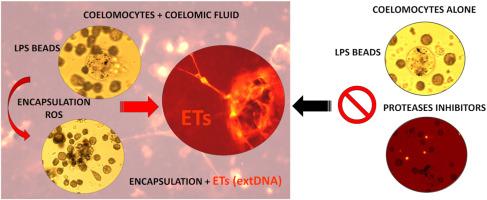蚯蚓体腔细胞释放胞外陷阱参与了蚯蚓的包封过程
IF 2.4
3区 农林科学
Q1 FISHERIES
引用次数: 0
摘要
蚯蚓有几种消除病原体的策略,包括:细胞毒性、吞噬、活性氧的产生和细胞外陷阱(ETs)的形成。反过来,对较大病原体(如寄生虫)的有效反应是基于随后的黑化和棕色体形成的包封。在我们的工作中,我们阐明了et和封装之间的相互作用。我们发现这种相互作用是时间依赖性的,并涉及体腔流体的体液成分。此外,我们还观察到琼脂糖珠在体外包被脂多糖(LPS)和在体腔液体体液成分存在的情况下进行包被时,琼脂糖珠的体外包被效果更好。它们的存在对et的形成也至关重要。此外,我们发现蛋白酶抑制剂减少琼脂糖珠诱导的包封和et的形成,体腔液和et的体液成分的存在增强了珠的包封和黑化过程。相反,LPS-bead诱导的ET形成不依赖于活性氧(ROS)。此外,我们发现在包封过程的第一步,细胞外DNA的释放可能有助于棕色体的形成。因此,可以总结为蚯蚓利用细胞毒性、吞噬作用、ROS产生和ET形成的组合来消除病原体。在体液成分和et的作用下,包封过程在它们的免疫反应中起着重要作用,尤其是对大型病原体的免疫反应。本文章由计算机程序翻译,如有差异,请以英文原文为准。

Extracellular traps release by coelomocytes in Eisenia andrei earthworm are involved in encapsulation process
Earthworms have several strategies for pathogen elimination including: cytotoxicity, phagocytosis, production of reactive oxygen species and formation of extracellular traps (ETs). In turn, an effective response against larger pathogens, such as parasites, is based on the encapsulation followed by melanization and formation of brown bodies. In our work, we elucidated interactions between ETs and encapsulation. We found that such interactions are time-dependent and involved humoral components of the coelomic fluids. Moreover, it was observed that in vitro encapsulation of agarose beads was much more effective when beads were coated with lipopolysaccharide (LPS) and when process took place in the presence of the coelomic fluid humoral components. Their presence was also crucial for ETs formation. Moreover, we found that protease inhibitors reduced agarose bead-induced encapsulation and ETs formation and that presence of humoral components of coelomic fluid and ETs enhanced encapsulation of the beads and the melanization processes. In contrast, induced by LPS-bead ET formation was not dependent on reactive oxygen species (ROS). Moreover, we discovered that in the first steps of encapsulation process, extracellular DNA release may help in the formation of the brown bodies. Therefore, it could be summarized that earthworms utilize a combination of cytotoxicity, phagocytosis, ROS production, and ET formation for pathogen elimination. The encapsulation process, enhanced by humoral components and ETs, plays a significant role in their immune response, particularly against large pathogens.
求助全文
通过发布文献求助,成功后即可免费获取论文全文。
去求助
来源期刊
CiteScore
6.20
自引率
6.90%
发文量
206
审稿时长
49 days
期刊介绍:
Developmental and Comparative Immunology (DCI) is an international journal that publishes articles describing original research in all areas of immunology, including comparative aspects of immunity and the evolution and development of the immune system. Manuscripts describing studies of immune systems in both vertebrates and invertebrates are welcome. All levels of immunological investigations are appropriate: organismal, cellular, biochemical and molecular genetics, extending to such fields as aging of the immune system, interaction between the immune and neuroendocrine system and intestinal immunity.

 求助内容:
求助内容: 应助结果提醒方式:
应助结果提醒方式:


